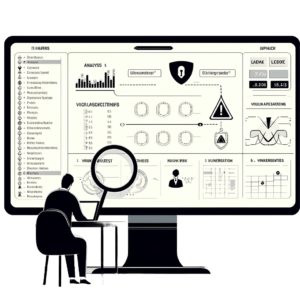Understanding the Concept of Vulnerability Assessment

In the world of cybersecurity, performing a vulnerability assessment is an important step in protecting your systems and data from potential threats. This detailed guide is here to help you understand what vulnerability assessment is and how it helps improve the overall security of an organization.
At its core, vulnerability assessment involves identifying, quantifying, and prioritizing vulnerabilities in a network, system, or application. By systematically scanning for weaknesses and misconfigurations, organizations can proactively address security gaps before malicious actors exploit them. Through a combination of automated tools and manual techniques, cybersecurity professionals can assess the susceptibility of their assets to various threats, ranging from known vulnerabilities to emerging risks.
In order to keep your organization safe from cyber threats, it’s important to not only identify vulnerabilities but also understand how they could harm your operations and reputation. By knowing the potential risks, you can create specific plans to protect your organization and prevent cyber attacks.
Keep following us as we explore the details of vulnerability assessment and give practical advice on how to navigate the constantly changing world of cybersecurity. Let’s work together to help organizations defend their online information and stay one step ahead of cyber attackers.
Importance and Need for Vulnerability Assessment
In today’s world of technology, it’s important for companies to regularly check for and fix any security weaknesses in their computer systems. This helps prevent cyber attackers from taking advantage of these vulnerabilities to hack into the company’s systems and cause problems.
A thorough vulnerability assessment is important for keeping data safe and protecting customer information. It also helps organizations follow industry rules and standards. By identifying and addressing security risks, companies can use their resources wisely and improve their overall security.
In addition, vulnerability assessments help identify security weaknesses in networks, applications, and systems, which allows organizations to quickly fix any problems. By doing thorough vulnerability assessments, businesses can stay ahead of ever-changing cyber threats and lower the risk of expensive data breaches and damage to their reputation.
Scope and Defining Your Assets
Defining the scope of your vulnerability assessment is crucial in ensuring that you thoroughly assess all potential security risks within your organization. Before diving into the assessment, it’s essential to identify and document all assets that need to be evaluated. Assets can include hardware such as servers, routers, and workstations, as well as software applications, databases, and even cloud services utilized by your organization.
By defining your assets, you can prioritize your assessment efforts and focus on the most critical components of your infrastructure. This step also helps in understanding the potential impact of vulnerabilities on your assets and allows you to allocate resources effectively. Additionally, understanding your assets enables you to tailor the assessment to specific systems and applications, ensuring a more targeted and thorough evaluation.
Furthermore, establishing the scope of your vulnerability assessment helps in setting boundaries and clarifying the objectives of the assessment. It allows you to determine whether external systems, internal networks, or specific applications are within the assessment’s scope. By clearly defining the scope, you avoid overlooking any crucial systems or areas that may pose security risks.
In conclusion, scoping and defining your assets are foundational steps in conducting a comprehensive vulnerability assessment. By clearly outlining the scope and identifying all assets, you can enhance the effectiveness of your assessment, prioritize security efforts, and better protect your organization from potential cyber threats.
Implementing Vulnerability Scanners and Tools
In the realm of cybersecurity, implementing vulnerability scanners and tools is crucial for organizations to proactively identify and mitigate potential security risks. A comprehensive guide on how to conduct a vulnerability assessment begins with understanding the importance of utilizing specialized tools to scan networks, systems, and applications for vulnerabilities. By deploying robust vulnerability scanners such as Nessus, Qualys, or OpenVAS, organizations can gain visibility into their security posture and remediate any weaknesses before they are exploited by malicious actors.
When implementing vulnerability scanners and tools, it is essential to establish a structured approach that includes setting scan schedules, defining scanning parameters, and configuring alerts for critical vulnerabilities. Additionally, organizations should prioritize scanning external-facing systems, internal networks, and web applications to identify a broad spectrum of vulnerabilities that could potentially be exploited.
By using security scanners and tools, companies can make sure their digital information is safe from hackers. This helps prevent data breaches and makes sure they follow the rules in their industry. Keeping an eye on possible security gaps with these tools is key in protecting against cyber attacks and keeping important data secure.
Analysis and Evaluation of Data
When conducting a vulnerability assessment, one of the crucial steps is the analysis and evaluation of data gathered during the assessment process. This phase involves identifying and prioritizing potential vulnerabilities in the system or network under examination. By carefully analyzing the data collected, cybersecurity professionals can gain insights into the weaknesses that could be exploited by malicious actors.
In addition, when looking at the data, we need to figure out how serious these weaknesses are for the organization’s overall security. By giving each weakness a risk rating based on factors like how much damage it could cause and how likely it is to be exploited, the security team can focus on fixing the most important issues first.
Furthermore, looking closely at the data helps organizations make smart choices about where to put their resources into fixing any security weaknesses. This method ensures that security teams are focusing on the most important security issues, making the system or network stronger overall.
In conclusion, the analysis and evaluation of data play a pivotal role in the vulnerability assessment process, guiding organizations towards proactive security measures and minimizing the risk of cyber threats.
Strategies for Vulnerabilities Mitigation
When it comes to checking for weaknesses in our system’s security, it’s important to have a plan in place to keep our data safe. One way to do this is by regularly updating and fixing any issues in the software and apps we use. It’s also a good idea to control who has access to certain parts of our system and keep an eye on what they’re allowed to do. This can help us stop unauthorized users from getting in and make it harder for attackers to find a way in.
Another important plan is to regularly hold safety classes for staff members. These classes will help increase their knowledge about common online scams, tricks people use to gain personal information and other usual ways attacks happen. This knowledge will prepare your staff to stay alert and be able to spot and report any possible security risks.
In addition, separating your network into different sections and using firewalls can help keep important information safe and reduce damage if there is a security breach. Making frequent backups of your data and storing it securely in other locations is also really important to minimize the harm caused by ransomware or data breaches.
By using these tips and staying ahead of potential security risks, you can make your organization’s cybersecurity stronger and reduce the chances of being targeted by cyber threats.
Effective Remediation Techniques
When conducting a vulnerability assessment, it is crucial to have a solid understanding of effective remediation techniques to address any identified weaknesses in your organization’s cybersecurity posture. Remediation involves taking action to mitigate or eliminate vulnerabilities that could potentially be exploited by malicious actors. One of the key techniques is prioritizing vulnerabilities based on their severity and the level of risk they pose to your systems.
An important way to fix security issues is to regularly update your software and systems. Just like how our immune system needs to be strong to fight off illness, our digital systems need the latest security updates to resist online threats. Also, setting up protective measures like firewalls correctly can help keep out unwanted visitors. They can even spot anything fishy happening right as it’s happening.
Regular security checks and testing are important for fixing security issues. By consistently testing your systems for weak spots, you can find and address security gaps before they are taken advantage of.
In conclusion, a proactive approach to remediation techniques is essential in maintaining a robust cybersecurity posture and safeguarding your organization against potential threats. By staying vigilant and consistently applying best practices, you can effectively protect your data and assets from cyber threats.
Penetration Testing vs Vulnerability Assessment
When it comes to keeping your digital information safe, it’s important to know the difference between penetration testing and vulnerability assessment. Both are important for finding security weaknesses, but they do different things.
Vulnerability assessment is like checking a house for weak spots without actually breaking in. It helps identify areas that could be targets for cyber attacks ahead of time. On the other hand, penetration testing takes it a step further by trying to break into a system to see how well it can withstand real attacks.
Despite their variances, penetration testing and vulnerability assessment are interrelated. Vulnerability assessment often precedes penetration testing, providing a baseline of identified vulnerabilities for penetration testers to exploit. The insights gained from vulnerability assessments can inform the scope and focus of penetration testing, enabling organizations to strengthen their overall security posture.
Developing a Routine for Regular Vulnerability Assessments
One of the essential components of a robust cybersecurity strategy is conducting regular vulnerability assessments. By developing a routine for these assessments, organizations can proactively identify and address potential security weaknesses before they can be exploited by malicious actors. Establishing a regular schedule for vulnerability assessments helps ensure that all systems, applications, and networks are thoroughly examined for any vulnerabilities that could pose a threat to the organization’s security posture.
Creating a structured approach to vulnerability assessments involves defining the scope of the assessment, selecting appropriate tools and methodologies, assigning responsibilities to skilled personnel, and documenting findings for remediation. By incorporating vulnerability assessments into a routine cybersecurity practice, organizations can stay ahead of emerging threats and prevent potential cybersecurity incidents.
Regular vulnerability assessments not only help in identifying and addressing existing vulnerabilities but also aid in compliance with regulatory requirements and industry standards. By making vulnerability assessments a routine part of your cybersecurity strategy, you can strengthen your overall security posture and reduce the risk of cyber-attacks and data breaches.
